Irish Decimal Coins Overview
Ireland switched from Pre-decimal coinage to Irish Decimal Coins on the 14th of February 1971.
Most of the designs of the pre-decimal coins by Percy Metcalfe were retained, apart from minor modifications, up to the demonetisation of the farthing and halfpenny in 1969.
With the introduction of Irish Decimal Coins in 1971, the penny, threepence, sixpence and half-crown were also withdrawn.
The shilling and florin coins were of equal value with the new 5p and 10p coins and the original designs were therefore adopted for these new coins. In addition, the woodcock design was adopted from the demonetised farthing to appear on the new 50p coin.
New designs were necessary for three Irish Decimal Coins: the ½p, 1p and 2p. Irish sculptor and artist, Gabriel Hayes, was commissioned to design these coins. The designs are based on ornamental details from Irish art illuminations contained in old manuscripts.
In 1986 the 20p coin was introduced. The design was again taken from an original pre-decimal coin design: the horse from the half-crown.
On 20 June 1990, Ireland issued its first-pound coin. This was issued to replace the £1 note and was designed by Thomas Ryan. In keeping with the original Metcalf animal motifs, the red deer, which is native to Ireland, was chosen for the design of the £1 coin.
Ireland officially adopted the euro as its currency on 1 January 1999. In advance of the euro changeover in 2002, the Irish Mint commenced full production of euro coins in August 1999. Production of IR£ ceased in September 2000 with the Millennium £1 circulating coin being the last national coin to be struck by the Irish Mint.
Half Penny Coin
The lowest denomination of the Irish Decimal coins, but The Decimal Irish Half Penny can be worth a staggering $2,000. This valuation earned the Decimal Half Penny a place on our Top 20 Valuable Irish Coins list.
Designed by Gabriel Hayes and produced in Ireland at the Currency Centre Dublin mint. In total 169,895,000 of these coins were minted.
Denomination: Half Penny
KM Code: KM# 19
Coin Series: Decimal 1969-2001
Years Produced: 1971 – 1986
Known Mintage: 169,895,000
Distribution: Standard Circulation
Mint: Currency Centre Dublin
Find out more information and values for the Irish decimal Half Penny here.
Penny Coin
The decimal penny was the second lowest denomination of the Irish Decimal coins
Designed by Gabriel Hayes and produced in Ireland at the Currency Centre Dublin mint.
The first Irish Penny was produced from 1971-1988, whilst the second Irish Penny was produced from 1990-2000.
Denomination: Penny
KM Codes: KM# 20 & KM# 20a
Coin Series: Decimal 1969-2001
Years Produced: 1971 – 2000
Known Mintage: 1,041,705,750
Distribution: Standard Circulation
Mint: Currency Centre Dublin
Find out more information and values for the Irish pennies on the links below;
Two Pence Coin
The decimal 2 pence was the third-lowest denomination of the Irish Decimal coins, and similarly to the Irish penny, there were two variations of this coin.
Designed by Gabriel Hayes and produced in Ireland at the Currency Centre Dublin mint.
The first Irish 2 pence was produced from 1971-1988, whilst the second Irish 2 pence coin was produced from 1990-2000.
Denomination: 2 Pence
KM Codes: KM# 21 & KM# 21a
Coin Series: Decimal 1969-2001
Years Produced: 1971 – 2000
Known Mintage: 579,766,750
Distribution: Standard Circulation
Mint: Currency Centre Dublin
Find out more information and values for the Irish 2 pence coins on the links below;
Five Pence Coin

The Five Pence was the fourth-smallest denomination of the Decimal 1969-2001-coin series of Ireland. There were two versions of Five Pence coin, the first is often referred to as the “Large” version and the other, as you would expect, is referred to as the “Small Version”.
This Five Pence coin was produced between the years 1969 -2000 at the Currency Centre Dublin mint.
Denomination: 5 Pence
KM Codes: KM# 22 & KM# 28
Coin Series: Decimal 1969-2001
Years Produced: 1969 – 2000
Distribution: Standard Circulation
Mint: Currency Centre Dublin
Find out more information and values for the Irish 5 pence coins on the links below;

Ten Pence Coin
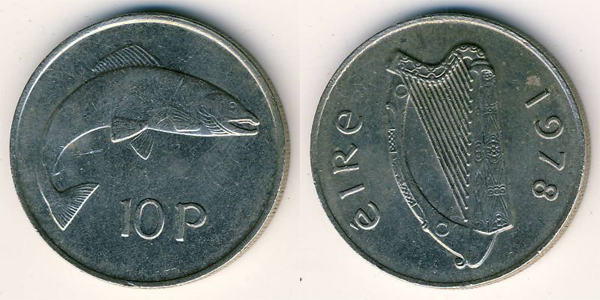
The 10 Pence coin was the fifth largest denomination in the Decimal 1969-2001-coin series of Ireland.
There were two versions of 10 Pence coin. the first 10 pence coin is referred to as the “Large” version and the other (this one), as you would expect, is referred to as the “Small Version”.
Denomination: 10 pence
KM Codes: KM# 23 & KM# 29
Coin Series: Decimal 1969-2001
Years Produced: 1969 – 2000
Distribution: Standard Circulation
Mint: Currency Centre Dublin
Find out more information and values for the Irish 10 pence coins on the links below;
10 Pence 1969-1986
10 Pence Coin 1993-2000

Twenty Pence Coin
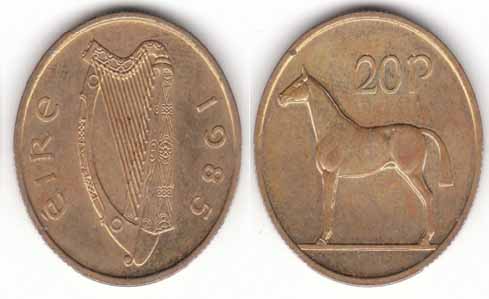
The 20 Pence coin was a third largest denomination in the Decimal 1969-2001-coin series of Ireland. The 20 Pence coin was produced between the years 1986 -2000 at the Currency Centre Dublin mint. In total 208,919,750 of these coins were produced.
There are a small number of 1985 20 Pence coins also which are valued up to $8,000 each. This valuation earned the Decimal Half Penny a place on our Top 20 Valuable Irish Coins list.
Denomination: 20 Pence
KM Codes:
Coin Series: Decimal 1969-2001
Years Produced: 1969 – 2000
Distribution: Standard Circulation
Mint: Currency Centre Dublin
Find out more information and values for the Irish 20 pence coins on the links below;

Fifty Pence Coin
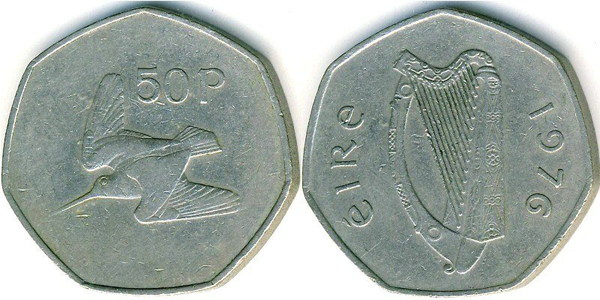
The 50 pence coin was the second largest denomination of decimal coin in Ireland. However, from 1970 until 1990, the 50 Pence coin was the largest denomination of Irish coin and was part of the Decimal 1969-2001-coin series of Ireland.
Designed by Percy Metcalfe and produced between the years 1970 -2000 at the Currency Centre Dublin mint.
There was also a circulating commemorative 50 pence coin that was made to celebrate the Dublin Millenium, you can read more about the 50 Pence Dublin Millenium coin here.
Denomination: 50 Pence
KM Codes:
Coin Series: Decimal 1969-2001
Years Produced: 1969 – 2000
Distribution: Standard Circulation & Circulating Commemorative
Mint: Currency Centre Dublin
More information on each of the 50 pence coins mentioned can be found on the below links.
50 Pence 1970-2000
50 Pence Dublin Millenium 1988

Punt Coin / Pound Coin
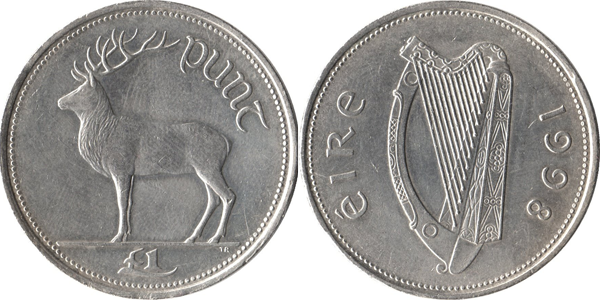
The 1 Punt coin was the largest denomination of decimal coin in Ireland. However, from 1970 until 1990, the 50 Pence coin was the largest denomination of Irish coin.
Designed by Thomas Ryan and produced between the years 1990 -2000 at the Currency Centre Dublin mint. In total 161,572,000 of these coins were minted. The video shown gives an overview of each of the decimal coins of Ireland.
There was also a circulating commemorative 1 Punt coin that was made to celebrate the Millenium, you can read more about the 1 Punt Millenium coin here.
Denomination: 1 Pound / 1 Punt
KM Codes:
Coin Series: Decimal 1969-2001
Years Produced: 1990 – 2000
Distribution: Standard Circulation
Mint: Currency Centre Dublin
More information on each of the pound coins mentioned can be found on the below links;
1 Punt 1990-2000
1 Punt Millenium 2000



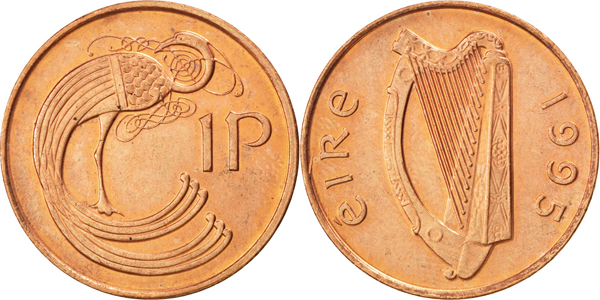
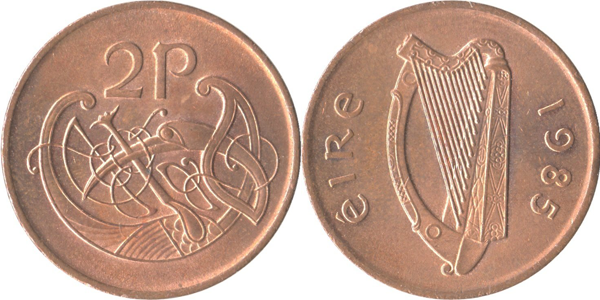
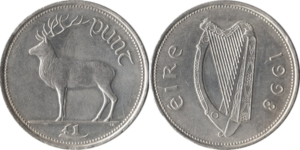
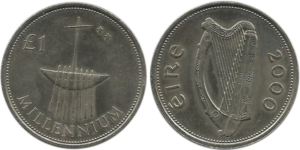
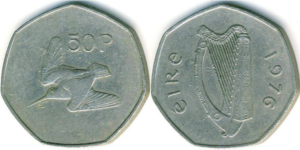
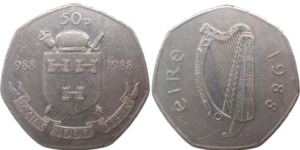
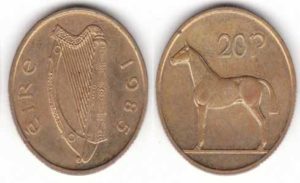
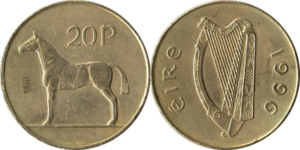
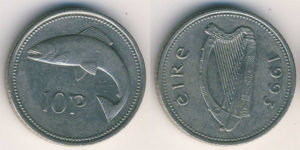

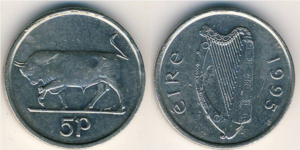
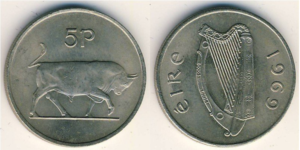
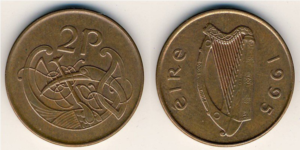
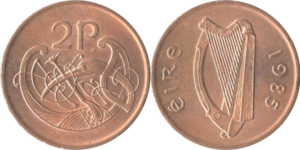
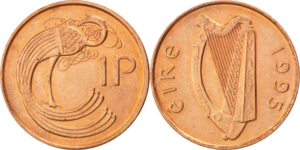
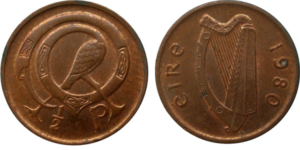
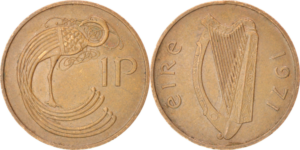

One Response
Are the 1973 50 pence coins with the hands on it worth anything